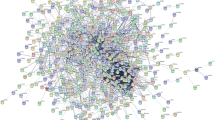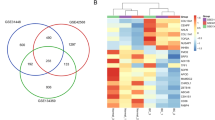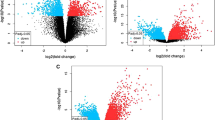Abstract
Breast cancer is the most common cause of death in women worldwide. Approximately 5%–10% of instances are attributed to mutations acquired from the parents. Therefore, it is highly recommended to design more potential drugs and drug targets to eradicate such complex diseases. Network-based gene expression profiling is a suggested tool for discovering drug targets by incorporating various factors such as disease states, intensities based on gene expression as well as protein–protein interactions. To find prospective biomarkers in breast cancer, we first identified differentially expressed genes (DEGs) statistical methods p-value and false discovery rate were initially used. Of the total 82 DEGs, 67 were upregulated while the remaining 17 were downregulated. Sub-modules and hub genes include VEGFA with the highest degree, followed by 15 CCND1 and CXCL8 with 12-degree score was found. The survival analysis revealed that all the hub genes have important role in the development and progression of breast cancer. Enrichment analysis revealed that most of these genes are involved in signaling pathways and in the extracellular spaces. We also identified transcription factors and kinases, which regulate proteins in the DEGs PPI. Finally, drugs for each hub genes were identified. These results further expanded the knowledge regarding important biomarkers in breast cancer.






Similar content being viewed by others
References
Vos T, Allen C, Arora M, Barber RM, Bhutta ZA, Brown A, Carter A, Casey DC, Charlson FJ, Chen AZ (2016) Global, regional, and national incidence, prevalence, and years lived with disability for 310 diseases and injuries, 1990–2015: a systematic analysis for the global burden of disease study 2015. The Lancet 388(10053):1545–1602. https://doi.org/10.1016/S0140-6736(16)31678-6
Sarma H, Mattaparthi VSK (2019) Structure-based virtual screening of high-affinity ATP-competitive inhibitors against human lemur tyrosine Kinase-3 (LMTK3) domain: a novel therapeutic target for breast cancer. Interdiscip Sci Comput Life Sci 11(3):527–541. https://doi.org/10.1007/s12539-018-0302-7
Su L, Meng X, Ma Q, Bai T, Liu G (2018) LPRP: a gene–gene interaction network construction algorithm and its application in breast cancer data analysis. Interdiscip Sci Comput Life Sci 10(1):131–142. https://doi.org/10.1007/s12539-016-0185-4
Liberati A, Altman DG, Tetzlaff J, Mulrow C, Gøtzsche PC, Ioannidis JP, Clarke M, Devereaux PJ, Kleijnen J, Moher D (2009) The PRISMA statement for reporting systematic reviews and meta-analyses of studies that evaluate health care interventions: explanation and elaboration. PLoS Med 6(7):e1000100. https://doi.org/10.1016/j.jclinepi.2009.06.006.
Stender JD, Kim K, Charn TH, Komm B, Chang KC, Kraus WL, Benner C, Glass CK, Katzenellenbogen BS (2010) Genome-wide analysis of estrogen receptor α DNA binding and tethering mechanisms identifies Runx1 as a novel tethering factor in receptor-mediated transcriptional activation. Mol Cell Biol 30(16):3943–3955. https://doi.org/10.1128/MCB.00118-10
Xia J, Gill EE, Hancock RE (2015) NetworkAnalyst for statistical, visual and network-based meta-analysis of gene expression data. Nat Protoc 10(6):823. https://doi.org/10.1038/nprot.2015.052
Stacklies W, Redestig H, Scholz M, Walther D, Selbig J (2007) pcaMethods—a bioconductor package providing PCA methods for incomplete data. Bioinformatics 23(9):1164–1167
Gentleman R, Carey V, Huber W, Irizarry R, Dudoit S (2006) Bioinformatics and computational biology solutions using R and Bioconductor. Springer Science & Business Media, Springer
Pettersen EF, Goddard TD, Huang CC, Couch GS, Greenblatt DM, Meng EC, Ferrin TE (2004) UCSF Chimera—a visualization system for exploratory research and analysis. J Comput Chem 25(13):1605–1612
Trott O, Olson AJ (2010) AutoDock Vina: improving the speed and accuracy of docking with a new scoring function, efficient optimization, and multithreading. J Comput Chem 31(2):455–461. https://doi.org/10.1002/jcc.21334
Chen Y-C, Hsiao C-C, Chen K-D, Hung Y-C, Wu C-Y, Lie C-H, Liu S-F, Sung M-T, Chen C-J, Wang T-Y (2013) Peripheral immune cell gene expression changes in advanced non-small cell lung cancer patients treated with first line combination chemotherapy. PLoS ONE One 8(2):e57053. https://doi.org/10.1371/journal.pone.0057053
Szklarczyk D, Morris JH, Cook H, Kuhn M, Wyder S, Simonovic M, Santos A, Doncheva NT, Roth A, Bork P (2016) The STRING database in 2017: quality-controlled protein–protein association networks, made broadly accessible. Nucleic Acids Res. https://doi.org/10.1093/nar/gkw937
Ma L, Huang Y, Zhu W, Zhou S, Zhou J, Zeng F, Liu X, Zhang Y, Yu J (2011) An integrated analysis of miRNA and mRNA expressions in non-small cell lung cancers. PLoS ONE One 6(10):e26502. https://doi.org/10.1371/journal.pone.0026502
Galvan A, Frullanti E, Anderlini M, Manenti G, Noci S, Dugo M, Ambrogi F, De Cecco L, Spinelli R, Piazza R (2013) Gene expression signature of non-involved lung tissue associated with survival in lung adenocarcinoma patients. Carcinogenesis 34(12):2767–2773. https://doi.org/10.1093/carcin/bgt294
Frullanti E, Colombo F, Falvella FS, Galvan A, Noci S, De Cecco L, Incarbone M, Alloisio M, Santambrogio L, Nosotti M (2012) Association of lung adenocarcinoma clinical stage with gene expression pattern in noninvolved lung tissue. Int J Cancer 131(5):E643–E648. https://doi.org/10.1002/ijc.27426
Chen EY, Tan CM, Kou Y, Duan Q, Wang Z, Meirelles GV, Clark NR, Ma’ayan A (2013) Enrichr: interactive and collaborative HTML5 gene list enrichment analysis tool BMC Bioinformatics 14(1): 128. Doi: 10.1186/1471-2105-14-128
Brandes U, Eiglsperger M, Herman I, Himsolt M, Marshall MS (2001) GraphML progress report structural layer proposal. In: International symposium on graph drawing, Springer, pp 501–512
Győrffy B, Surowiak P, Budczies J, Lánczky A (2013) Online survival analysis software to assess the prognostic value of biomarkers using transcriptomic data in non-small-cell lung cancer. PLoS ONE One 8(12):e82241. https://doi.org/10.1371/journal.pone.0082241
Schröder MS, Culhane AC, Quackenbush J, Haibe-Kains B (2011) survcomp: an R/Bioconductor package for performance assessment and comparison of survival models. Bioinformatics 27(22):3206–3208. https://doi.org/10.1093/bioinformatics/btr511
Wishart DS, Feunang YD, Guo AC, Lo EJ, Marcu A, Grant JR, Sajed T, Johnson D, Li C, Sayeeda Z (2017) DrugBank 50: a major update to the DrugBank database for 2018. Nucleic Acids Res 46(D1):D1074–D1082. https://doi.org/10.1093/nar/gkx1037
Arora D, Chaudhary R, Singh A (2019) System biology approach to identify potential receptor for targeting cancer and biomolecular interaction studies of indole [2, 1-a] isoquinoline derivative as anticancerous drug candidate against it. Interdiscip Sci Comput Life Sci 11(1):125–134. https://doi.org/10.1007/s12539-017-0249-0
Wang Y, Cai Y, Miao Y (2015) Evolving-pattern analysis of transient and long-term biomarkers for cancers: hepatocellular carcinoma as a case. Interdiscip Sci Comput Life Sci 7(4):414–422. https://doi.org/10.1007/s12539-015-0276-7
Li G-G, Wang Z-Z (2009) Evaluation of similarity measures for gene expression data and their correspondent combined measures. Interdiscip Sci Comput Life Sci 1(1):72–80. https://doi.org/10.1007/s12539-008-0005-3
Hu B, Chang X, Liu X (2019) Predicting functional modules of liver cancer based on differential network analysis. Interdiscip Sci Comput Life Sci 11(4): 636–644. https://doi.org/10.1007/s12539-018-0314-3
Liu S, Wang X, Qin W, Genchev GZ, Lu H (2018) Transcription factors contribute to differential expression in cellular pathways in lung adenocarcinoma and lung squamous cell carcinoma. Interdiscip Sci Comput Life Sci 10(4):836–847. https://doi.org/10.1007/s12539-018-0300-9
Ni Q-S, Wang Z-Z, Li G-G, Wang G-Y, Zhao Y-J (2009) Effect of the quality of the interaction data on predicting protein function from protein-protein interactions. Interdiscip Sci Comput Life Sci 1(1):40–45. https://doi.org/10.1007/s12539-008-0015-4
Ma R, Wang C, Wang J, Wang D, Xu J (2016) miRNA–mRNA Interaction Network in Non-small Cell Lung Cancer. Interdiscip Sci Comput Life Sci 8(3):209–219. https://doi.org/10.1007/s12539-015-0117-8
Khan A, Ali A, Junaid M, Liu C, Kaushik AC, Cho WC, Wei D-Q (2018) Identification of novel drug targets for diamond-blackfan anemia based on RPS19 gene mutation using protein-protein interaction network. BMC Syst Biol 12(4):39. https://doi.org/10.1186/s12918-018-0563-0
Selvaraj G, Kaliamurthi S, Kaushik AC, Khan A, Wei Y-K, Cho WC, Gu K, Wei D-Q (2018) Identification of target gene and prognostic evaluation for lung adenocarcinoma using gene expression meta-analysis, network analysis and neural network algorithms. J Biomed Inform 86:120–134. https://doi.org/10.1016/j.jbi.2018.09.004
Malhotra AG, Jha M, Singh S, Pandey KM (2018) Construction of a comprehensive protein-protein interaction map for Vitiligo disease to identify key regulatory elements: a systemic approach. Interdiscip Sci Comput Life Sci 10(3):500–514. https://doi.org/10.1007/s12539-017-0213-z
Nayarisseri A, Yadav M, Wishard R (2013) Computational evaluation of new homologous down regulators of translationally controlled tumor protein (TCTP) targeted for tumor reversion. Interdiscip Sci Comput Life Sci 5(4):274–279. https://doi.org/10.1007/s12539-013-0183-8
Liu Y, Tamimi RM, Collins LC, Schnitt SJ, Gilmore HL, Connolly JL, Colditz GA (2011) The association between vascular endothelial growth factor expression in invasive breast cancer and survival varies with intrinsic subtypes and use of adjuvant systemic therapy: results from the Nurses’ Health Study. Breast Cancer Res Treat 129(1):175–184. https://doi.org/10.1007/s10549-011-1432-3
Roy PG, Pratt N, Purdie CA, Baker L, Ashfield A, Quinlan P, Thompson AM (2010) High CCND1 amplification identifies a group of poor prognosis women with estrogen receptor positive breast cancer. Int J Cancer 127(2):355–360. https://doi.org/10.1002/ijc.25034
Afzali F, Salimi M (2019) Unearthing regulatory axes of breast cancer circRNAs networks to find novel targets and fathom pivotal mechanisms. Interdiscip Sci Comput Life Sci 11(4):711–722. https://doi.org/10.1007/s12539-019-00339-6
PA Ruffini (2019) The CXCL8-CXCR1/2 Axis as a therapeutic target in breast cancer stem-like cells. Front Oncol 9:636–644. https://doi.org/10.3389/fonc.2019.00040
Sun X, Glynn DJ, Hodson LJ, Huo C, Britt K, Thompson EW, Woolford L, Evdokiou A, Pollard JW, Robertson SA (2017) CCL2-driven inflammation increases mammary gland stromal density and cancer susceptibility in a transgenic mouse model. Breast Cancer Res 19(1):4. https://doi.org/10.1186/s13058-016-0796-z
Wei C-Y, Tan Q-X, Zhu X, Qin Q-H, Zhu F-B, Mo Q-G, Yang W-P (2015) Expression of CDKN1A/p21 and TGFBR2 in breast cancer and their prognostic significance. Int J Clin Exp Pathol 8(11):14619
Barupal DK, Gao B, Budczies J, Phinney BS, Perroud B, Denkert C, Fiehn O (2019) Prioritization of metabolic genes as novel therapeutic targets in estrogen-receptor negative breast tumors using multi-omics data and text mining. Oncotarget 10(39):3894. https://doi.org/10.18632/oncotarget.26995
Desmedt C, Haibe-Kains B, Wirapati P, Buyse M, Larsimont D, Bontempi G, Delorenzi M, Piccart M, Sotiriou C (2008) Biological processes associated with breast cancer clinical outcome depend on the molecular subtypes. Clin Cancer Res 14(16):5158–5165. https://doi.org/10.1158/1078-0432.CCR-07-4756
Fasoulakis Z, Kolios G, Papamanolis V, Kontomanolis EN (2018) Interleukins associated with breast cancer. Cureus 10(11):1–17. https://doi.org/10.7759/cureus.3549
Nicolini A, Ferrari P, Diodati L, Carpi A (2018) Alterations of signaling pathways related to the immune system in breast cancer: new perspectives in patient management. Int J Mol Sci 19(9):2733. https://doi.org/10.3390/ijms19092733
Funding
Dong-Qing Wei is supported by the grants from the Key Research Area Grant 2016YFA0501703 of the Ministry of Science and Technology of China, the National Natural Science Foundation of China (Contract no. 61832019, 61503244), the Natural Science Foundation of Henan Province (162300410060) and Joint Research Funds for Medical and Engineering and Scientific Research at Shanghai Jiao Tong University (YG2017ZD14). The computations were partially performed at the Center for High-Performance Computing, Shanghai Jiao Tong University.
Author information
Authors and Affiliations
Contributions
AK, AAK, ZR and HFH conceptualized the methodology. AK, AAK and HFH did the analysis. AK, AS, SSA, FH and DQW wrote the manuscript. DQW supervised the study. All the authors approved the manuscript.
Corresponding authors
Ethics declarations
Conflict of interest
The authors declare no conflict of interest.
Electronic supplementary material
Below is the link to the electronic supplementary material.
Rights and permissions
About this article
Cite this article
Khan, A., Rehman, Z., Hashmi, H.F. et al. An Integrated Systems Biology and Network-Based Approaches to Identify Novel Biomarkers in Breast Cancer Cell Lines Using Gene Expression Data. Interdiscip Sci Comput Life Sci 12, 155–168 (2020). https://doi.org/10.1007/s12539-020-00360-0
Received:
Revised:
Accepted:
Published:
Issue Date:
DOI: https://doi.org/10.1007/s12539-020-00360-0




